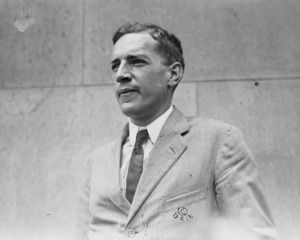End Poverty in California facts for kids
End Poverty in California (or EPIC) was a big plan in 1934. It was started by a writer named Upton Sinclair, who was known for his book The Jungle. This idea became the main part of Sinclair's campaign to become Governor of California in 1934. The EPIC plan wanted to create many jobs through public works projects. It also aimed to change taxes and make sure older people and those in need got money. Many people liked the idea, and thousands joined "End Poverty Leagues" across California. EPIC didn't happen because Sinclair lost the election in 1934. However, many believe it helped inspire the New Deal programs started by President Franklin D. Roosevelt.
Contents
What Was the EPIC Plan?
Sinclair wrote about his EPIC ideas in a 1933 book. It was called I, Governor of California, and How I ended Poverty: A True Story of the Future.
How the Plan Would Work
The EPIC plan suggested that the state should take over empty factories and farms. These were places where owners had not paid their property taxes. The government would then hire people who didn't have jobs to work on these farms and in these factories. The farms would be run by the workers themselves. They would produce their own food and goods.
Tax Changes and Support
EPIC also wanted California to have its first state income tax. This tax would be a progressive tax. This means richer people would pay a higher percentage of their income in taxes. The wealthiest people would pay up to 30%. The plan also aimed to increase taxes on money inherited from family. It would also add a small tax on stock trades. EPIC also included money for older people, disabled people, and widows. This was like a pension or support payment.
New Government Groups
To make EPIC happen, Sinclair wanted to create three new government groups:
- The California Authority for Land (CAL)
- The California Authority for Production (CAP)
- The California Authority for Money (CAM)
CAL would manage taking over and farming the unused lands. CAP would do the same for empty factories. CAM would help pay for CAL and CAP. It would do this by giving special money (called scrip) to workers. It would also sell bonds to buy land, factories, and machines.
The EPIC Campaign for Governor
Upton Sinclair had tried to get elected to the U.S. Congress twice before. He was part of the Socialist Party. But after President Roosevelt was elected in 1932, Sinclair decided to join the Democratic Party in 1933.
Growing Support for EPIC
Soon, many people started supporting EPIC. Thousands joined "End Poverty Leagues" all over California. A weekly newspaper called the EPIC News was created to support the plan. By August 1934, when the main election for governor was near, almost a million copies of the paper were being printed. Many candidates who supported EPIC also won their primary elections for state legislature seats.
Challenges and Opposition
However, Sinclair did not get full support from the Democratic Party leaders. President Roosevelt himself did not support Sinclair. Roosevelt thought the EPIC plan was too extreme. Sinclair's opponents said he wanted to "Sovietize California," meaning they claimed he wanted to make California like the Soviet Union.
The Socialist Party in California and across the country did not allow its members to work with other parties. They removed Sinclair and other socialists who supported his campaign. This ended up weakening the Socialist Party in California.
Strong Opposition from Others
EPIC faced strong opposition from the Republican Party and major media companies. According to a 2017 article, opponents of EPIC ran a very expensive and clever campaign against it. They were the first to use outside advertising and media experts for a major political campaign.
Leaders of Hollywood's big movie studios were strongly against EPIC. This was partly because Sinclair wanted to give empty movie studio lots to unemployed film workers. These workers could then make their own movies. The studio heads reacted by threatening to move their film work to Florida. They also took money from employee paychecks to help pay for Sinclair's Republican opponent, Frank Merriam. Two very powerful newspaper owners, William Randolph Hearst and Harry Chandler, also used their papers to support Merriam and attack Sinclair.
Election Results
Because of all this opposition, and without Roosevelt's support, Sinclair fell behind Merriam in the polls. On November 6, 1934, Merriam won the election. He received 1,138,629 votes (48.9%). Sinclair received 879,537 votes (37.8%). Even though he lost, Sinclair got twice as many votes as any other Democratic candidate for governor before him. Also, two dozen candidates who ran on the EPIC platform were elected to the state legislature. This included Culbert Olson, who later became Governor four years later.
The EPIC Movement Continues
The EPIC movement did not stop after Sinclair lost the election. Between 1934 and 1938, it helped remove a mayor, a district attorney, and elect a new governor. This was according to Robert A. Heinlein, who was a publisher for the EPIC News at the time. Heinlein also ran for the State Assembly in 1938 but lost. After that, he started writing science fiction to pay off his campaign debts.
EPIC's Lasting Impact
Even though Upton Sinclair lost, the EPIC plan is seen as having a big impact on President Roosevelt's New Deal programs. In late 1934, Harry Hopkins, a key advisor to Roosevelt, suggested an "End Poverty in America" campaign. The New York Times newspaper wrote that this new plan was different in small ways, but similar in its main idea to Sinclair's plan.
In 2022, Michael Tubbs, a former Mayor of Stockton, started a new group. It's called "End Poverty in California" (EPIC) and works to fight poverty. He was inspired by Upton Sinclair's original campaign.


